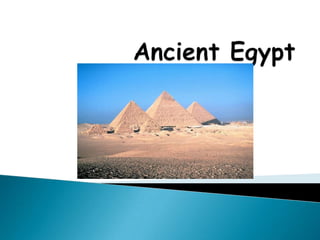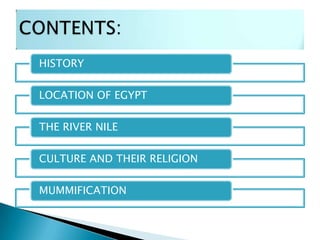Ancient Egypt
- 3. HISTORY LOCATION OF EGYPT THE RIVER NILE CULTURE AND THEIR RELIGION MUMMIFICATION
- 4. Around, About 5000 BC the weather changed and the Sahara became the Sahara Desert. The people who lived in the Sahara before needed a place to get water and live so they went out on a hunt for water and found a river so they called this land The Nile Valley at that time.
- 7.       Flooded every year Provided fertile soil for crops Was the “Lifeline” for Egypt Transportation Route Used for Irrigation Flows south to north
- 8. Main crops were barley, wheat and flax ÔÅΩ Main food was bread, fish, vegetables and fruit. Only the wealthy ate meat. ÔÅΩ
- 9. Egyptian Social Pyramid Egyptian Social Classes were based on wealth, job and education
- 11. ÔÅΩ ÔÅΩ People built homes from mud bricks Most important people had better houses.
- 12. ÔÅΩ Egyptians developed a form of picture or symbol writing.
- 14.    Egyptians believed that when people die, they move on to another world. Since people needed their body in the afterlife, it would need to be “preserved.” The process of mummification was developed.
- 16. ÔÅΩ ÔÅΩ ÔÅΩ ÔÅΩ Language: Picture Coded Architecture: Pyramids Inventions: 365 day calendar, papyrus (paper), irrigation system, mathematics, medicine, weapons. Art: statues, paintings, jewelry
















